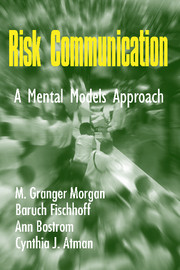Book contents
- Frontmatter
- Contents
- Preface
- Risk Communication
- 1 INTRODUCTION
- 2 OUR MENTAL MODELS APPROACH
- 3 CREATING AN EXPERT MODEL OF THE RISK
- 4 MENTAL MODELS INTERVIEWS
- 5 CONFIRMATORY QUESTIONNAIRES
- 6 DEVELOPMENT AND EVALUATION OF COMMUNICATIONS
- 7 CASE STUDIES: APPLICATIONS TO ENVIRONMENTAL RISKS
- 8 A MENTAL MODELS APPROACH TO HIV/AIDS
- 9 SOME CONCLUDING THOUGHTS
- Appendix A Brochure on global warming and climate change
- Appendix B Brochure on fields from electric power
- Appendix C Risk communication materials on HIV/AIDS
- Appendix D Sample transcripts of mental model interviews
- Index
7 - CASE STUDIES: APPLICATIONS TO ENVIRONMENTAL RISKS
Published online by Cambridge University Press: 05 June 2012
- Frontmatter
- Contents
- Preface
- Risk Communication
- 1 INTRODUCTION
- 2 OUR MENTAL MODELS APPROACH
- 3 CREATING AN EXPERT MODEL OF THE RISK
- 4 MENTAL MODELS INTERVIEWS
- 5 CONFIRMATORY QUESTIONNAIRES
- 6 DEVELOPMENT AND EVALUATION OF COMMUNICATIONS
- 7 CASE STUDIES: APPLICATIONS TO ENVIRONMENTAL RISKS
- 8 A MENTAL MODELS APPROACH TO HIV/AIDS
- 9 SOME CONCLUDING THOUGHTS
- Appendix A Brochure on global warming and climate change
- Appendix B Brochure on fields from electric power
- Appendix C Risk communication materials on HIV/AIDS
- Appendix D Sample transcripts of mental model interviews
- Index
Summary
This chapter applies the general methods of the previous chapters to develop risk communications in four specific areas: climate change, power-frequency electric and magnetic fields, radon in homes, and nuclear energy sources on spacecraft.
Climate Change
The possibility that human activities are changing our climate has emerged as one of the primary environmental concerns of our era. Water vapor and carbon dioxide, which occur naturally in the earth's atmosphere, trap heat, giving the earth a temperature that supports life. This natural process is called the “greenhouse effect.” Burning fossil fuels releases additional carbon dioxide into the atmosphere. Some is taken up by plants or dissolved in the ocean, but about half remains in the atmosphere. Since the beginning of the industrial revolution, the concentration of carbon dioxide has increased by about 30%. Without dramatic changes in how we produce or use energy, that concentration will continue to rise. The amount of heat that is trapped will also increase, probably making the earth's climate warmer, modifying patterns of atmospheric and ocean circulation, changing patterns of precipitation, and causing changes in the human and ecological systems that depend on climate.
We began our studies of public understanding of global climate change by constructing a series of influence diagrams similar to the one reproduced in Figure 3.11. We used it to guide pilot mental models interviews with seven staff and graduate students at Carnegie Mellon University.
- Type
- Chapter
- Information
- Risk CommunicationA Mental Models Approach, pp. 125 - 159Publisher: Cambridge University PressPrint publication year: 2001



